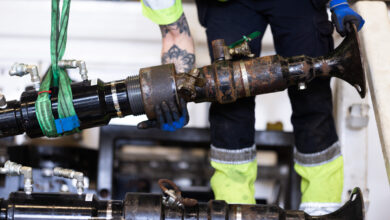Gallegos: Record-setting AC-drive rigs reduce cycle times, drilling costs
By Lauren Wolfson, editorial assistant, and Joanne Liou, associate editor

Since 2008, many supermajors, large independents and even NOCs have increased their focus on land drilling in North America, investing nearly US $150 billion in unconventional plays, according to IHS Herold. Anthony Gallegos, senior vice president and CFO of Sidewinder Drilling, explained at the 2013 IADC Annual General Meeting that this trend has expanded the customer base and market for onshore drilling contractors, driving a demand for new and more advanced rigs.
“The rig fleet that was out there was not going to be suited for the unconventional plays,” Mr Gallegos said. “We launched Sidewinder (in 2011) with a goal to bring a new generation of equipment to the markets supported by industry-leading systems, processes and personnel.”
In the past five years, 600 to 700 newbuilds have entered the US onshore market, Mr Gallegos stated, and new-generation AC-drive rigs have become the rig of choice because of the prevalence of extended lateral well sections. Sidewinder currently has 45 rigs, five of which are walking AC units. The newest of the fleet is the Canebrake Rig 105, a 1,500-hp AC unit with 10 independent “feet” and is capable of walking between wells and across pads. With six feet under the back yard, which houses the mud system, mud pits and power-generating units, and four feet under the substructure mast, Rig 105 can walk in any direction, according to Sidewinder.
Sidewinder’s walking and skidding AC-drive rigs have set drilling records for major operators, such as Anadarko, XTO and Statoil, “including breaking 10 of the 20 records which Statoil tracks in the Bakken,” Mr Gallegos said. He noted recent operating successes in which Sidewinder set a Bakken field horizontal drilling record of 3,347 ft in 24 hrs, along with EP Energy’s Permian record of 6.17 days from spud to total depth.
With new-generation rigs increasing efficiency, operators are seeing significant reductions in cycle times and drilling costs, Mr Gallegos explained. For example, Sidewinder drilled 17,000-ft wells in the Eagle Ford in less than eight days and 22,000-ft wells in the Bakken in 16 days, he said. “At Sidewinder, we see it as a positive, much like the introduction of top drives back in the late ‘80s and early ‘90s. As we help our customers lower total well cost, they can drill more wells and ultimately bring more oil and gas fields into economic viability,” Mr Gallegos said. “We should not fear efficiency but instead embrace and ride the trend.”
With this increase in efficiency, a focus on safety and well integrity is essential, especially as operations occur closer to local communities and people’s homes. Sidewinder has reduced the company’s TRIR by 53% from 5.50 within the past year, Mr Gallegos stated, and plans to reduce it by another 50% in the next 12 months.
“Thanks to a lot of hard work on the part of our operations and HSE people, the support of our customers, the implementation of our safety management system, and change of the culture of the companies we’ve acquired, we’re making good progress,” Mr Gallegos said. “Enhanced vigilance of our customers’ casing programs, proper management of the condition and test frequency of our BOPs and good housekeeping at the drill site, along with good noise abatement, are all required in today’s resource plays. We’re working hard to get better.”
In addition to the improved rig efficiencies and safety record, Mr Gallegos called on industry to consider the increased drilling intensity on US land along with the manning of rigs. A land rig might drill 400,000 ft each year while it’s manned by the same crew size as 20 years ago, despite the increase in demands from customers and increased drilling intensity, Mr Gallegos said. “It’s not just an economic issue, but it’s a safety issue.”





Anthony,
Looks as though you are setting new standards for the land market. Congratulations!
Ben Nowotny